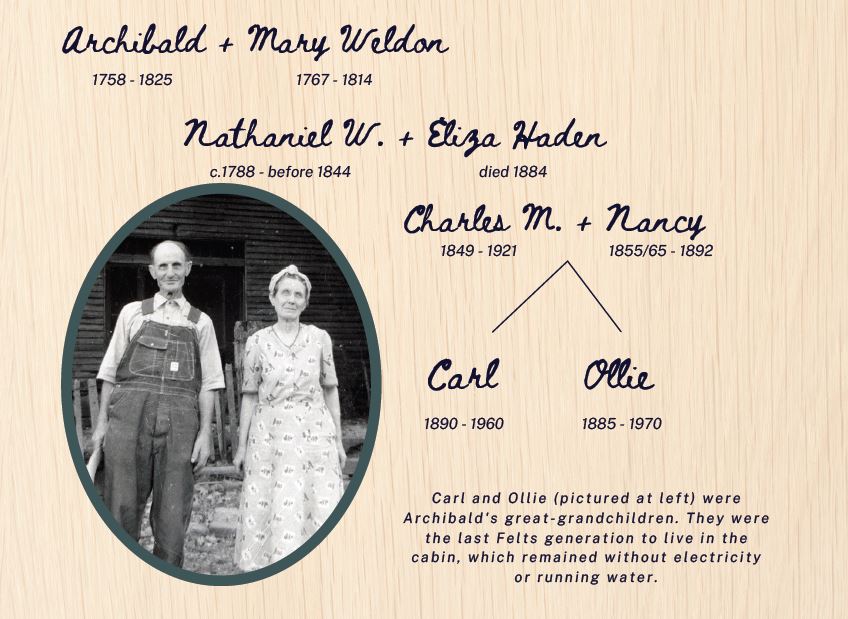Felts House Family and House Information
 Between 1797 and 1810, Archibald Felts received land grants in what is now Logan County
as payment for his service in the Revolutionary War. Archibald built a small cabin
on the land, then moved his family from Virginia to Logan County. Family lore states
the cabin was burned by Native Americans, and the family lived in a cave while building
the current house, which was completed around 1810 to 1815. This placed Archibald
and his family among the first generation of permanent settlers in Kentucky. Archibald's
descendants lived in the house until the 1960s.
Between 1797 and 1810, Archibald Felts received land grants in what is now Logan County
as payment for his service in the Revolutionary War. Archibald built a small cabin
on the land, then moved his family from Virginia to Logan County. Family lore states
the cabin was burned by Native Americans, and the family lived in a cave while building
the current house, which was completed around 1810 to 1815. This placed Archibald
and his family among the first generation of permanent settlers in Kentucky. Archibald's
descendants lived in the house until the 1960s.
Archibald Felts was born in Sussex County, Virginia, on February 23, 1758. He was the second son of Nathaniel Felts, Jr. (d. 1784) and Anne Bullock Felts (d. 1790). Nathaneil Jr. may have been the son of Thomas Felts (1696-1769) and grandson of Humphrey Felts (1648-1715), who is listed in colonial tithe records starting in 1674. Research on this genealogy is ongoing.
Sussex County is southwest of Jamestown, Virginia, so it is probable that Felts ancestors originally lived in or passed through Jamestown.
Kentucky is the traditional home of the Cherokee, Osage, Shawnee, and Yuchi. Before 1770, the British negotiated treaties with these tribes, maintaining a delicate peace by curbing settlement. After the Revolutionary War, the United States did not recognize these treaties or the rights of Indigenous peoples. Instead, the cash-strapped government granted land to veterans as compensation for their service.
The Felts family probably encountered some of these peoples, thought we do nto have records of specific meetings. Family lore indicates that Archibald's land grant was part of the post-Revolution disputes between white settlers and Native peoples.
The family Bible lists the births of six children: Sally (1785), Nathaniel W. (1788), Elizabeth "Betsy" (1790), William L. (1792), Samuel (1794), and Polly (1797). However, census data indicates more people lived in the home, probably apprentices or extended kin. In his will, Archibald divided his land and goods between Mary and his children. Nathaniel inherited the log house, which later passed on to Nathaniel's son, Charles, and then to Charles's children, Ollie and Carl.

No. There is no record of Archibald Felts or his descendants owning slaves.
They did have apprentices, including 8-year-old William Lowry and two young sisters, Polly and Sally Bowler. This was common among middle and upper-class families as a way for children to learn skills and socialize.
Days consisted of work and play. Work included making candles and soap, grinding corn into meal, drying fruits and meats, gathering firewood, stoking the hearth, cooking, agriculture, husbandry, and spinning fabric into clothing and household linens. Play included visiting neighbors to swap stories, sing songs, and hold contests in marksmanship. Neighbors also gathered for quilting parties, corn huskings, house raisings, and weddings. Despite owning much land on the frontier, the Felts family had many neighbors and could visit neighboring towns when needed - including Russellville and Bowling Green. The family also hosted an annual "Cemetery Day" gathering for their family and friends to celebrate their shared history and remember deceased loved ones.
Move to WKU
In 1968, Ollie Felts sold the family land and house to Sam Houston Watkins. Ten years later, Sam donated the house to the Kentucky Museum to be used as a living history classroom. The house was moved to WKU in 1980, and eventually opened to the public in 1983.
In 1990, the Museum received a grant from the State of Kentucky/Warren County Fiscal Court to furnish the cabin with period appropriate materials dating to the 1830s, the period directly after Archibald's death, due to the lack of existing research on the Felts family at the time. Folk Studies students utilized 1830s estate inventories from Logan County to reconstruct what the interior probably contained. One room was a parlor for formal entertaining, while the other was a hall for informal family use. The middle passage provided space for work tables and tools, sheltered from rain. The upstairs rooms were used for sleeping and storage.
Since then, many faculty, staff, and students have complied a variety of research and resources about both the Felts family and the house.
Restoration
In 2019, historic preservationist Andy Mills assessed the Felts Log House. Water leaks, rodents, and the use of concrete had deteriorated the house to critical condition. With the support of the E. Rhodes and Leona B. Carpenter Foundation, Mills undertook restoration work in 2021. Using reclaimed materials, Mills restored the structure as close as possible to its original appearance.
Andy Mills is considered to be one of the top consultants in the country, given his extensive knowledge of antique log restoration and early building methods. Now retired, his career included consulting on several state historical projects. The Felts House was one of his last full restoration projects.
Further Resources
The links below provide a variety of documents and information related to the Felts family and the house. Special thanks to the Department of Library Special Collections
- Photos - See Flickr album.
- Map - Original Location of House in Logan County
- Felts Family Information
- Land Grants - Archibald Felts was given two tracts of land: the first on June 11, 1797, was for 200 acres in Logan County; the second on January 22, 1810, was for an additional 200 acres.
- Archibald Felts’ Will
- Bible Record
- House Information
- Theses and Research Papers
- K-12 Materials


